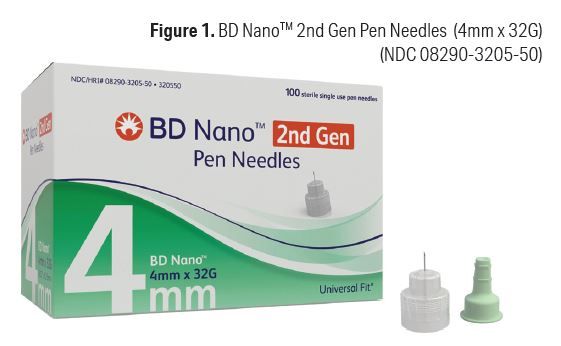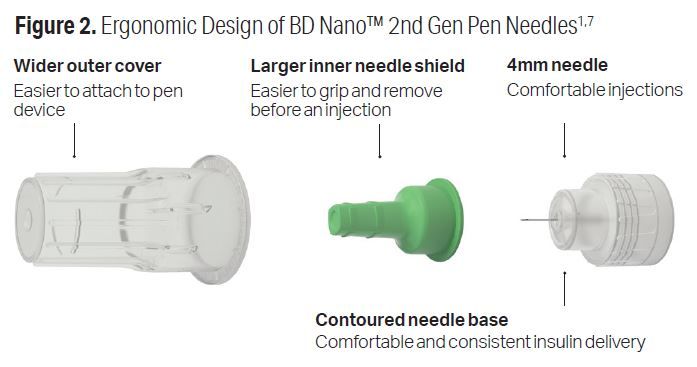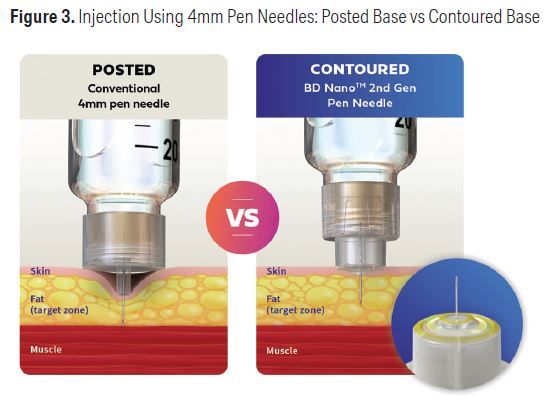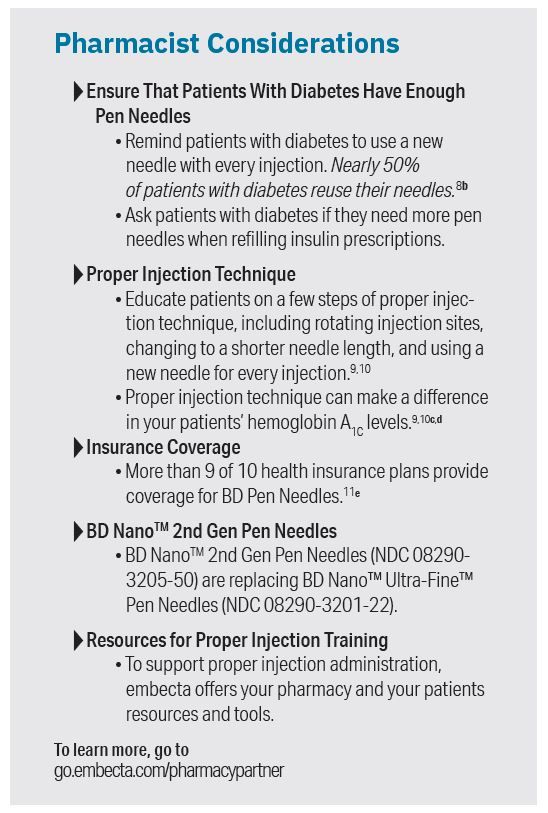Patients With Diabetes Deserve Easier, More Comfortable Insulin Injections
This article is sponsored by embecta, formerly part of Becton, Dickinson and Company (BD). BD is the manufacturer of the advertised product.
Help Your Patients Improve Their Insulin Injection Experience With
BD Nano™ 2nd Gen Pen Needles1
With over 30 million Americans living with diabetes, approximately 7.4 million use insulin to manage their condition.2,3 Insulin is to be injected into the subcutaneous space; however, unintended intramuscular (IM) insulin injections can lead to unexpected fluctuations in blood glucose.4
In patients with diabetes, IM injection of insulin can affect proper insulin absorption.4 In addition to being associated with frequent hypoglycemia, IM injection can lead to increased pain, bleeding, and bruising.5 Results of a 2020 survey involving 230 adults with type 1 diabetes (T1D) or type 2 diabetes (T2D) demonstrated that 100% of patients were making at least 1 injection technique error.6 76% of patients reported applying excessive injection force, which was the most common error.6 Emphasizing the importance of proper injection technique to patients is an important step when it comes to managing their diabetes.
BD Nano™ 2nd Gen Pen Needles
The contoured base and overall design of BD NanoTM 2nd Gen Pen Needles is estimated to reduce the risk of IM injection vs comparator pen needles (Figure 1).1,7a

Patient Preference
In a prospective, crossover trial, adults with diabetes familiar with using pen devices reported that BD NanoTM 2nd Gen Pen Needles were preferred overall and were rated easier and more comfort able to use compared to other pen needles studied. The design of BD NanoTM 2nd Gen Pen Needles was rated by participants and features the following components5f:
- Ergonomic design: Patients favoredBD NanoTM 2nd Gen Pen Needles overall and shared that the entire pen needle experience—from needle attachment through disposal—was easier compared with all comparator pen needles combined. Patients also reported that BD NanoTM 2nd Gen Pen Needles were more comfortable to use (Figure 2).
- Wider outer cover: Patients preferred the wider outer cover of BD NanoTM 2nd Gen Pen Needles vs the outer covers of conventional pen needles. They found that the wider outer cover provided easier attachment of the pen needle to the pen device.
- Larger inner needle shield: Patients favored the inner shield of this device overall and found it easier to grip and remove before an injection.
- Contoured needle base: Patients reported that, during injection, the contoured needle base was more comfortable and allowed the pen to be held more securely against the skin.
- 4mm needle: Patients reported experiencing less injection pain when using BD NanoTM 2nd Gen Pen Needles 4mm needles, which use a 5-bevel tip and ultra-thin–wall technology.

Contoured Needle Base
The contoured needle base of BD NanoTM 2nd Gen Pen Needles is designed to compensate for excessive injection force (Figure 3).7 When compared with posted base pen needles, use of a contoured-base pen needles for injection has been estimated to reduce IM injection risk by approximately 2 to 8 times.7g

Conclusions
Patients with diabetes have demonstrated a preference for BD NanoTM 2nd Gen Pen Needles and their ergonomic design, wider outer cover, larger inner needle shield, 5-bevel tip, and ultra-thin–wall technology overall in comparison with otherpen needles.1 Compared with posted base pen needles, BD NanoTM 2nd Gen Pen Needles may reduce the risk of IM injection by approximately 2 to 8 times and may help mitigate the associated risks of altered insulin absorption as well as frequent hypoglycemia.4,5,7g These updates to BD NanoTM 2nd Gen Pen Needles have improved the injection experience for patients. Pharmacists can help educate patients on proper injection technique by pro-viding resources on injection technique training to support their insulin administration experience.
aThe study used in-silico probability model of needle penetration depth for posted-hub 4mm pen needles and average human tissue thickness measurements across a range of injection forces and recommended sites, pooled across gender and BMI.7
b13,289 patients with diabetes who inject insulin participated in an injection technique questionnaire. 38.8% of the 2,711 patients using insulin syringes reported needle reuse. 55.8% of the 11,961 patients using pen needles reported needle reuse.8
c43 patients with diabetes on insulin treatment participated in a study evaluating changes in glycated hemoglobin (HbA1C) following structured insulin injection training. Mean baseline HbA1c = 8 .7 ± 1 .4. Results were significant at P < 0 .001. No regression analysis was conducted to evaluate the impact of pen needles on HbA1C.9
d346 patients with diabetes on insulin treatment participated in a study evaluating changes in glycated hemoglobin (HbA1C) following insulin injection training. Mean baseline HbA1C = 8.49 ± 2.86. Results were significant at P < 0 .05. No regression analysis was conducted to evaluate the impact of pen needles on HbA1C.10
eBased on the percentage of people in the United States who have coverage for BD NanoTM 2nd Gen Pen Needles. Placement on formulary does not establish clinical comparability of products, including safety and efficacy. Embecta does not guarantee full or partial coverage or preferred formulary access on any given plan. Contact health plan, state, or www.medicare.gov for most current information, as it may change without notice. Embecta does not sponsor or endorse any particular plan, and companies/plans with embecta coverage do not imply their endorsement of embecta or the product(s) referenced.11
fBased on results of a randomized, prospective, open-label study of 226 adults with T1D or T2D. Patients used a 150 mm–long comparative visual analog scale (VAS) (mean scores of > 0 mm; clinically significant difference of ≥ 5 mm) to respond to questions about their experience using BD NanoTM 2nd Gen Pen Needles and posted-hub pen needles. For each question, an aggregate mean VAS and a 2-sided 95% CI were calculated; a product was considered to be superior if the lower bound of the CI was > 0 mm. Across all responses, BD NanoTM 2nd Gen Pen Needles were demonstrated to be superior to all comparator pen needles combined (P < .05). Versus all comparator pen needles combined, patients favored BD NanoTM 2nd Gen Pen Needles overall (VAS; 95% CI) (17 mm; 10.3-24.7 mm) and regarding ease of experience from attachment through disposal (19.9 mm; 13.8-25.9 mm), comfort of use (18 mm; 11.3-24.7 mm), outer cover (19.1 mm; 13.2-25.0 mm), ease of using outer cover to attach pen needle to pen device (21.8 mm; 16.1-27.6 mm), inner shield (24.6 mm; 18.9-30.4 mm), ease of gripping inner shield (23.8 mm; 18.1-29.4 mm), removing inner shield (24.4 mm; 18.9-29.9 mm), holding pen securely against the skin (17.0 mm; 11.3-22.6 mm), comfort when held against skin during injection (16.9 mm; 10.8-23.0 mm), and less injection pain (15.5 mm; 8.9-22.1 mm).1
gBased on results of an in vivo preclinical study of 1200 injections using 4mm pen needles across a range of force levels by experienced insulin pen users. Nonoverlapping CIs between devices indicated a statistically significant difference. Versus posted-hub pen needles, across injection sites, and when pooled across body mass index and gender, BD NanoTM 2nd Gen Pen Needles displayed a risk reduction of approximately 2 to 8 times.7
REFERENCES
- Whooley S, Briskin T, Gibney MA, Blank LR, Berube J, Pflug BK. Evaluating the user performance and experience with a reengineered 4 mm x 32G pen needle: a randomized trial with similar length/gauge needles. Diabetes Ther. 2019;10(2):697-712. doi:10.1007/s13300-019-0585-7
- Centers for Disease Control and Prevention. National diabetes statistics report. Published June 29, 2022. Accessed July 21, 2023. https://www.cdc.gov/diabetes/data/statistics-report/index.html
- Cefalu WT, Dawes DE, Gavlak G, et al. Insulin Access and Affordability Working Group: Conclusions and recommendations. Diabetes Care. 2018;41(6):1299-1311. doi:10.2337/dci18-0019
- American Diabetes Association. Introduction and methodology: standards of medical care in diabetes - 2023. Diabetes Care. 2023;46(Suppl 1):S1-S24. doi:10.2337/dc23-Sint2
- Frid AH, Kreugel G, Grassi G, et al. New insulin delivery recommendations. Mayo Clin Proc. 2016;91(9):1231-1255. doi:10.1016/j.mayocp.2016.06.010
- Bari B, Corbeil M-A, Farooqui H, et al. Insulin injection practices in a population of Canadians with diabetes: an observational study. Diabetes Ther. 2020;11(11):2595-2609. doi:10.1007/s13300-020-00913-y
- Rini C, Roberts BC, Morel D, Klug R, Selvage B, Pettis RJ. Evaluating the impact of human factors and pen needle design on insulin pen injection. J Diabetes Sci Technol. 2019;13(3):533-545. doi:10.1177/1932296819836987
- Frid AH, Hirsch LJ, Menchior AR, Morel DR, Strauss KW. Worldwide injection technique questionnaire study: population parameters and injection practices. Mayo Clin Proc. 2016;91(9):1212-1223. doi:10.1016/j.mayocp.2016.06.011
- Misnikova IV, Gubkina VA, Lakeeva TS, Dreval AV. A randomized controlled trial to assess the impact of proper insulin injection technique training on glycemic control. Diabetes Ther. 2017;8(6):1309-1318. doi:10.1007/s13300-017-0315-y
- Grassi G, Scuntero P, Trepiccioni R, Marubbi F, Strauss K. Optimizing insulin injection technique and its effect on blood glucose control. J Clin Transl Endocrinol. 2014;1(4):145-150. Published 2014 Jul 23. doi:10.1016/j.jcte.2014.07.006
- Fingertip Formulary (as of 01/04/2023)
Lean Six Sigma: Helping Long-Term Care Pharmacies Thrive in a Challenging Market
April 15th 2024Long-Term Care (LTC) pharmacies are playing a critical role in delivering care primarily for our aging population. Yet LTC pharmacies face many challenges, including rising costs, space constraints, labor availability and many others.
